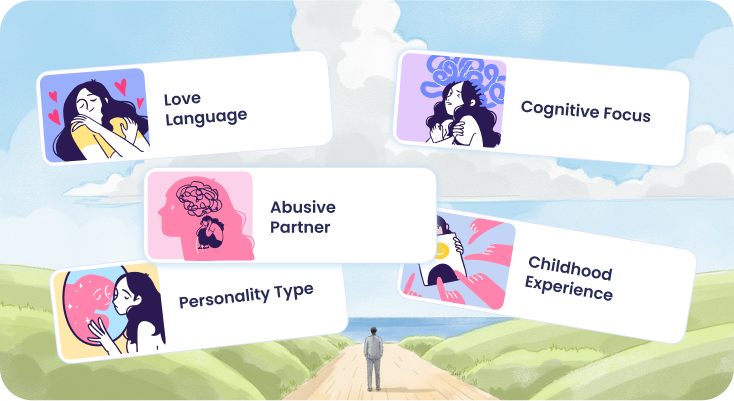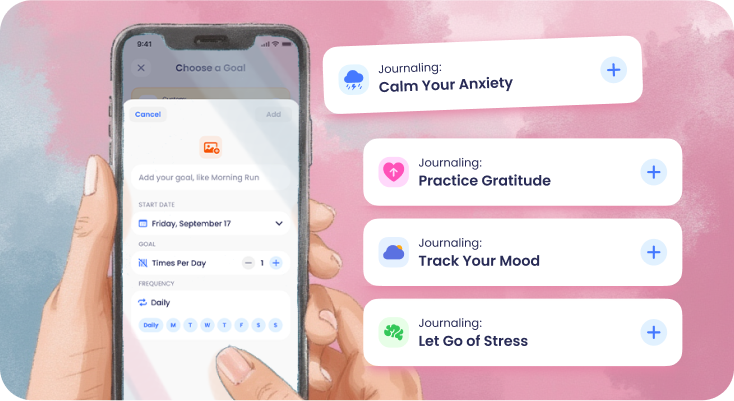Networking is one of the most effective ways to obtain greater status and authority in your social life and meet people who can share new job and business opportunities, according to Harvard Business Review research [1]. However, networking can be difficult and unpleasant if you feel uncomfortable in a room with many strangers, thinking, “I wish I knew how to talk to people comfortably”.
Here are a few tricks on how to make a good first impression, master small talk, use body language to express confidence, and develop strong verbal communication skills.
Want to see how ready you are? Take a quick Emotional Intelligence Test and gain insights into whether you can establish deep subliminal rapport with people using your empathy and social skills.
14 Tips on How to Talk to Anyone and Influence People
To learn how to talk to anyone, you can try sophisticated techniques from the popular self-help and communication skills book, “How to Talk to Anyone: 92 Little Tricks for Big Success in Relationships” by Leil Lowndes, together with Breeze tips and real-life examples [2]:
1. Adopt a straight shooting style
If you are wondering how to talk to anyone and make a memorable first impression, you first need to adopt a straight-shooting style.
Here’s how this concept is presented in the “How to Talk to Anyone” book:
- Speak with confidence. People are naturally attracted to those who sound like they know what they’re talking about.
- Be clear and get straight to the point.
- Avoid words that make you sound uncertain, like “maybe,” “I think,” or “sort of”.
- Balance with warmth. Even when being direct, maintain a friendly and non-aggressive tone.
In other words, this “magic quality” makes people want to keep talking to you, remember you, and feel impressed by your social skills and interaction.
If social situations often make you anxious, try taking the social anxiety test. You can also explore other Breeze tests about relationships, career, and personality to better understand your communication and behavior patterns, identify your strengths, and be the best version of yourself.

2. Try a “flooding smile”
Your body language can make you seem more connected. According to the “7-38-55 Rule” developed by psychology professor Albert Mehrabian, only 7% of meaning comes from the words you say [3].
About 38% comes from your tone of voice, and the remaining 55% comes from your body language.” That’s why a warm smile, intense eye contact, straight posture, and calm gestures can instantly signal your friendliness and confidence.
Leil Lowndes offers practicing the flooding smile. Instead of flashing a quick, automatic smile at everyone, wait a second before smiling and make it look genuine. Let your face “light up” slowly as if the person made your day.
3. Use “the big-baby pivot”
When someone starts speaking, turn your whole body toward them, like a baby looking at a parent. It’s a nonverbal gesture that shows complete attention and makes people feel valued. Show a genuine interest in the person’s job, opinions, and interests, and hang on to your conversation partner’s every word.
Expert Insight
Try to remind yourself of your inherent strengths. Remember that most people want to be engaged and connected to others. They’re not looking to undermine or criticize you. If you can lean into this, you may feel more at ease before socializing.
Nicole Arzt
Mental health professional
4. Use “never the naked introduction” rule
Leil Lowndes advises never just saying your job title when someone asks what you do. Why? Because simply saying “I’m a lawyer” or “I’m a teacher” gives the other person nothing interesting to react to, and the topic ends right there.
Instead, she suggests wrapping your job in an intriguing “teaser” and saying something short and catchy to invite follow-up questions. Talk about what your work does rather than just your role.
Tip from Breeze
If you introduce two people to each other yourself, don’t just say, “Susan, meet John”. It typically leaves both people stuck or feeling awkward, not knowing what to talk about. Try also to follow the rule “never the naked job” and “never the naked city” to give people more than just a title or location.
Spice up your introductions with a little context. For example, “Susan, I’d like you to meet John, my old friend. John has a wonderful boat that we took a trip on last summer. John, this is Susan Smith. Susan is a chief operating officer in our company and also loves hiking”. This way, you can give two people a conversational hook and relatable topics for a small talk.
5. Try “Warm Up After the Reveal”
Follow your introduction with a friendly comment or question to keep the conversation natural and engaging. For example, “Hi, I’m Robert. I love this event. Have you been here before?” It prevents awkward silences, makes your greeting feel genuine, and encourages the other person to open up. This, in turn, can turn a simple introduction into a real conversation.
6. Match and mirror
This technique can help you if you’re wondering how to calm down and feel more in control while having a conversation. People naturally feel more comfortable with those who seem similar to them, so you can use empathetic reflection. Subtly match the other person’s body language, tone, and energy level.
For example, if they speak softly and lean forward, do the same. If they’re enthusiastic, mirror their energy naturally. Try to avoid copying them exactly, as that can feel awkward or insincere.

7. Remember names
The brain scans show that hearing your own name activates specific areas, which can make a person feel more connected and valued [3]. Once you have met someone, try to address them by name. Here’s a simple life hack to remember names effectively:
- Repeat it right away. When you hear the name, say it back: “Nice to meet you, Sarah.”
- Visual association. Link the name to an image or a rhyme. For example, “Tom” → imagine a tomato.
- Connect to something you know. Associate a new person with someone else you know with the same name or a characteristic they have.
- Use it in conversation. Try to say their name a few times naturally while talking.
- Focus fully. Don’t think about your reply while they’re speaking. Give your full attention when they introduce themselves.
Looking for tools to boost your confidence? Personalized daily affirmations in the Breeze app can ease anxiety and clear your mind to connect naturally with others.

8. Compliment sincerely
Compliments are an easy way to delicately highlight a positive trait in another person and start a small talk. Only compliment what you truly mean and try to be specific. Instead of: “You’re great!” try something like “You have a real talent for bringing the team together and keeping everyone motivated” or “You’re brilliant in storytelling. I forget about time when I listen to you.”
Here are a few more important tips on how to make killer compliments:
- focus on abilities rather than appearance;
- point out the difference their actions make;
- сomment on what you actually noticed, not assumptions.
Do you often give compliments?
9. Use “The Hansel and Gretel Technique”
If you think about how to talk to anyone and make new friends as an adult, try dropping little “breadcrumbs” about yourself instead of giving long monologues. For instance, say, “I started hiking last year…”. It encourages them to ask, “Oh, where do you hike?” which, in turn, keeps conversations dynamic and balanced.
Knowing your personality type can be the first step in building strong personal and professional relationships. Take an insightful test!
10. Don’t one-up people too fast
If someone shares an experience or achievement, avoid responding by trying to top it with your own words. For example, if they say, “I ran 5 miles today,” don’t reply with, “Oh, I did 10 yesterday.” Instead, keep the focus on them by showing interest: “Wow, 5 miles! That’s impressive. Are you training for anything?” This makes the other person feel valued and heard, which naturally makes you more likable.
11. Use the echo effect
Repeat the last few words someone says in a questioning tone. For example, if they say, “I just got back from Italy,” you can respond with, “Italy?” This simple technique encourages them to share more details about their experience and shows that you’re actively listening and engaged in what they’re saying.
Expert Insight
When in doubt, aim to listen more than talk. This is an important rule of thumb when first getting to know someone. Showing curiosity about someone else’s life conveys that you care to get to know them. That said, make sure you also share about yourself- people want to know you, too!
Nicole Arzt
Mental health professional
12. Create an instant history
People tend to respond positively when they feel a connection, even if it’s small or recent. The following tip aims to reference shared experiences or interests to trigger a feeling of familiarity and friendliness in the other person. Here’s how it works:
- Mention something you both know, like the event you’re attending, a mutual friend, or a shared interest. For example, at a conference, instead of just saying, “Hi, I’m Alex,” you could say, “Hi, I noticed you were at the marketing panel earlier. I thought the insights on social media trends were fascinating!”
- Make it feel personal. Even small details like “I see you’re reading ‘How to Talk to Anyone. ‘ I just finished it last week!” create a sense of shared experience.
13. Decode people’s signals
This is about reading the room and responding naturally so the conversation feels comfortable for everybody. Pay attention to people’s body language, tone of voice, and facial expressions to understand how they really feel. For example, if they seem uneasy, switch topics. Or, if they’re excited, match their energy and join in enthusiastically. Noticing small signals shows you really care and are listening.
If you wonder how to get motivated and make socializing feel more like a fun game than a daunting task, the Breeze app can help you set up a goal and track your progress. For example, you can create a challenge like “Meet 10 new people tonight” and mark off each conversation as you go.

14. “Leave an escape hatch”
In line with the concept of “How to Talk to Anyone”, aim to give people an easy, graceful way to exit a conversation without feeling trapped or awkward. In most cases, people are more willing to talk again if they leave on their own terms.
For example, you might end a chat with a warm phrase like “It was great catching up! I don’t want to keep you, so I’ll let you get back to your day.” This creates a polite exit and allows a person to leave the interaction on a positive note. If they do still want to talk, it gives them the opportunity to express that directly.
Sources
- Francesca Gino, Maryam Kouchaki, Tiziana Casciaro. Learn to Love Networking. May 2016
- Leil Lowndes. “How to Talk to Anyone: 92 Little Tricks for Big Success in Relationships”. October, 2003
- Albert Mehrabian. Silent Messages: Implicit Communication of Emotions and Attitudes.
- Carmody DP, Lewis M. Brain activation when hearing one’s own and others’ names. Brain Res. October 2006
Disclaimer
This article is for general informative and self-discovery purposes only. It should not replace expert guidance from professionals.
Any action you take in response to the information in this article, whether directly or indirectly, is solely your responsibility and is done at your own risk. Breeze content team and its mental health experts disclaim any liability, loss, or risk, personal, professional, or otherwise, which may result from the use and/or application of any content.
Always consult your doctor or other certified health practitioner with any medical questions or concerns
Breeze articles exclusively cite trusted sources, such as academic research institutions and medical associations, including research and studies from PubMed, ResearchGate, or similar databases. Examine our subject-matter editors and editorial process to see how we verify facts and maintain the accuracy, reliability, and trustworthiness of our material.
Was this article helpful?





